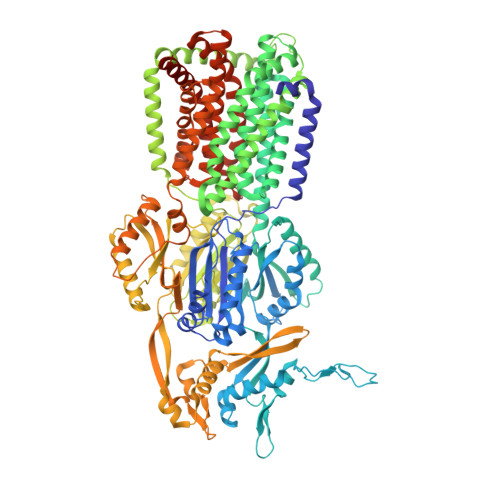Cryo-EM Structures of the Klebsiella pneumoniae AcrB Multidrug Efflux Pump.
Zhang, Z., Morgan, C.E., Bonomo, R.A., Yu, E.W.(2023) mBio 14: e0065923-e0065923
- PubMed: 37067435
- DOI: https://doi.org/10.1128/mbio.00659-23
- Primary Citation of Related Structures:
8FFK, 8FFS - PubMed Abstract:
The continued challenges of the COVID-19 pandemic combined with the growing problem of antimicrobial-resistant bacterial infections has severely impacted global health. Specifically, the Gram-negative pathogen Klebsiella pneumoniae is one of the most prevalent causes of secondary bacterial infection in COVID-19 patients, with approximately an 83% mortality rate observed among COVID-19 patients with these bacterial coinfections. K. pneumoniae belongs to the ESKAPE group of pathogens, a group that commonly gives rise to severe infections that are often life-threatening. Recently, K. pneumoniae carbapenemase (KPC)-producing K. pneumoniae has drawn wide public attention, as the mortality rate for this infection can be as high as 71%. The most predominant and clinically important multidrug efflux system in K. pneumoniae is the acriflavine resistance B (AcrB) multidrug efflux pump. This pump mediates resistance to different classes of structurally diverse antimicrobial agents, including quinolones, β-lactams, tetracyclines, macrolides, aminoglycosides, and chloramphenicol. We here report single-particle cryo-electron microscopy (cryo-EM) structures of K. pneumoniae AcrB, in both the absence and the presence of the antibiotic erythromycin. These structures allow us to elucidate specific pump-drug interactions and pinpoint exactly how this pump recognizes antibiotics. IMPORTANCE Klebsiella pneumoniae has emerged as one of the most problematic and highly antibiotic-resistant pathogens worldwide. It is the second most common causative agent involved in secondary bacterial infection in COVID-19 patients. K. pneumoniae carbapenemase (KPC)-producing K. pneumoniae is a major concern in global public health because of the high mortality rate of this infection. Its drug resistance is due, in a significant part, to active efflux of these bactericides, a major mechanism that K. pneumoniae uses to resist to the action of multiple classes of antibiotics. Here, we report cryo-electron microscopy (cryo-EM) structures of the prevalent and clinically important K. pneumoniae AcrB multidrug efflux pump, in both the absence and the presence of the erythromycin antibiotic. These structures allow us to understand the action mechanism for drug recognition in this pump. Our studies will ultimately inform an era in structure-guided drug design to combat multidrug resistance in these Gram-negative pathogens.
- Department of Pharmacology, Case Western Reserve University School of Medicine, Cleveland, Ohio, USA.
Organizational Affiliation:
















